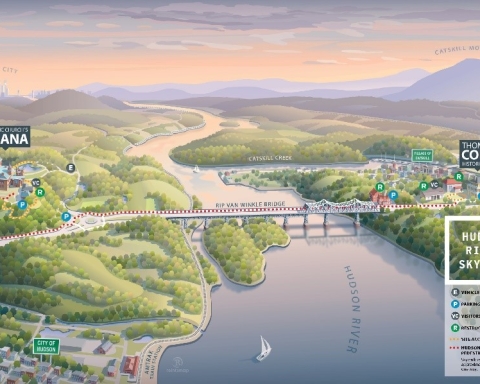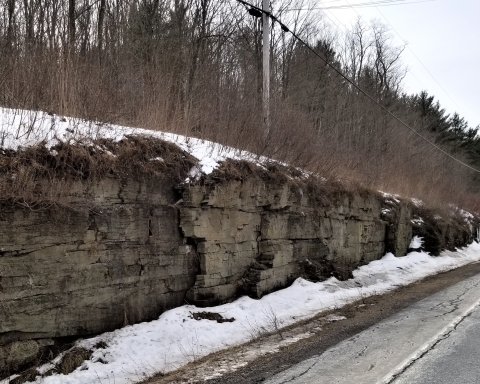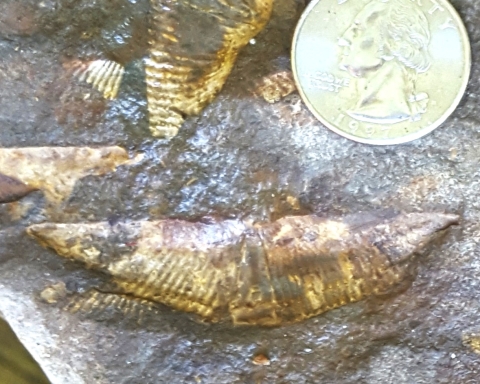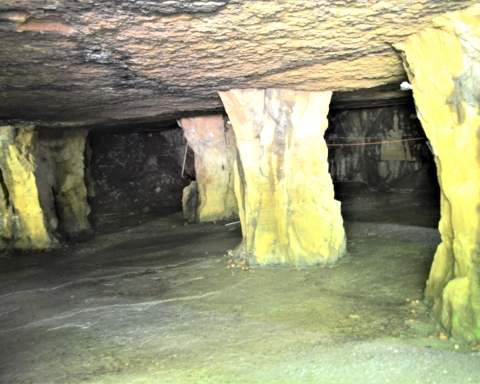The Hudson River Art Trail: Site four, Kaaterskill Clove
Windows Through Time
Feb. 26, 2015
Robert and Johanna Titus
Today we continue our journey following the Hudson River Art Trail. Conceived and implemented by Cedar Grove, the Thomas Cole Historic Site, the Art Trail takes visitors to sites where they can view the scenery first painted by members of the Hudson River School of Art. Today we visit site number four. That is Kaaterskill Clove. Windows Through Time has visited the Clove frequently to describe the geology that is there in abundance. Today is no exception, but we will view the geology in terms of the landscape it produced and the landscape art that it inspired.
The art trail guide will lead you to the Molly Smith parking lot. That’s a bit more than halfway up the mountain along Rte. 23A. It’s the most substantial parking lot in Kaaterskill Clove. If you get there before 10:00 on most weekdays you will probably find a space to park. If you come on a summer weekend, then we wish you good luck. If you can park, you will be drawn toward the back of the lot where you will find an art trail poster. These are to be found at all sites. They explain what was painted at each particular location.
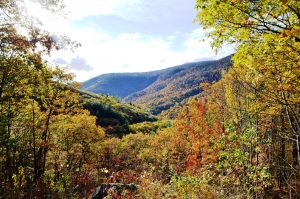
Beyond the Molly Smith poster is a fine view of Kaaterskill Clove. It shows the deep chasm that is there. It is a yawning gulf that stretches out far downstream and almost as far upstream. The dimensions are impressive. From Haines Falls where it begins, down to Palenville where it ends, it stretches almost five miles. It’s a mile across and, at its deepest, it’s roughly 1,500 feet from top to bottom. We think that it is the best scenery east of the Rocky Mountains!
The artists of the Hudson River School surely thought so as well. They visited here and frequently painted it. There are good vantage points at Haines and Kaaterskill Falls. More views can be obtained from the cliffs rising above Rte. 23A. We love the view from Poet’s Ledge.
That one offers the best vista looking west and up the canyon. Wonderful views can also be seen from the trails which follow the north and south rims of the Clove.
Thomas Cole painted it in 1825. The Clove was visited and painted by Asher Brown Durand, and Frederic Church. What landscape artist could resist such a place? But, although we are geologists, we believe we are inspired much as they were. But, more to the point, we see this landscape as they could not, and we paint it with words. Our views and our word paintings are rooted in the distant ice age past.
Our vantage point requires the challenging hike to Poet’s Ledge. You take the Blue Trail up from Palenville and turn right onto the Yellow Trail. Soon you descend onto a fine bluestone ledge which rewards your efforts with a sweeping and truly breathtaking panorama of the whole clove. It must be the best clove view that can be found. Make this hike at the peak of the leaf season and see if you can ever forget this scene.
But we see it as it was toward the end of the Ice Age, and, not just any moment, but a very special one. The closing chapters of that glacial epoch witnessed the melting of the ice that had covered the Catskills. Stand on Poet’s Ledge and look up. Once a full 2,000 feet of ice lay above. Think about that for a moment, and then imagine what happened when it all melted. Our journey into the late ice age past will take us to see that.
There must have been day and an hour when more meltwater passed down this clove than ever had before and ever would again. We stand atop Poet’s Ledge and we see the very moment all this was happening. We look up and see a thunderous fountain of water emerging from the top of a nearly hidden Haines Falls. The speed of this monumental jet is so great that momentum carries the water out far above the canyon before gravity can pull it down. This peculiar ancient Haines Falls makes the modern falls pale in significance. That great spout drops to the bottom of the canyon and its flow is soon joined by a rush of water almost as powerful. This one is emerging from the canyon below Kaaterskill Falls.
Now the two flows combine to make a single powerful torrent, flowing on down the gorge. The roars echo off its steep walls. These are the reverberations of the surges that carved the chasm those artists painted. We have been watching the actual formation of Kaaterskill Clove.
Contact the authors at randjtitus@prodigy.net. Join their facebook page ”The Catskill Geologist.”

